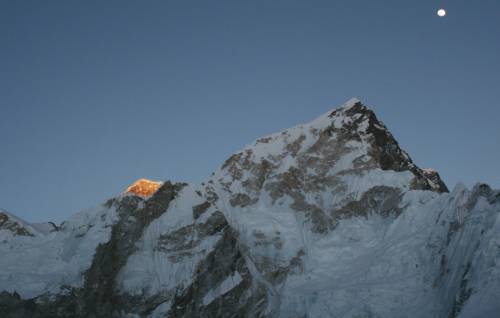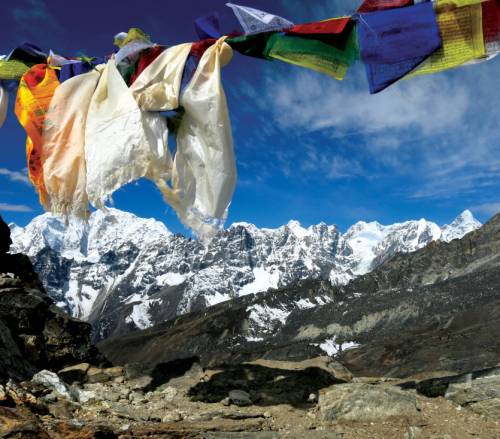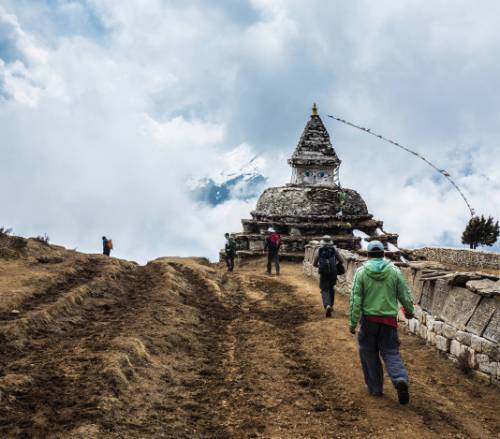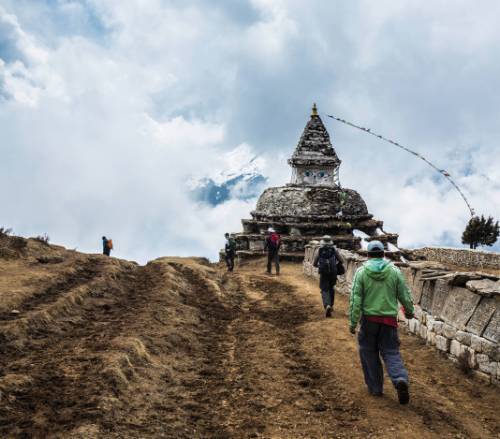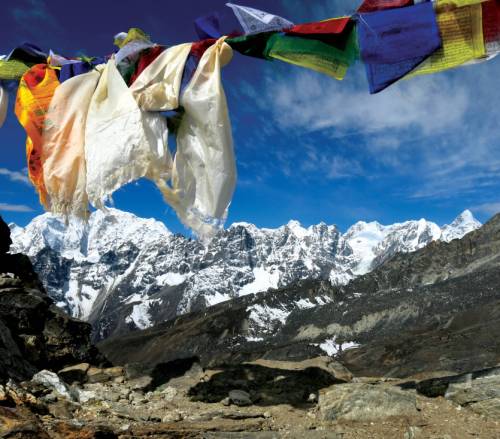GHT Everest & Rolwaling Traverse via Tashi Labsta Pass
GHT Everest & Rolwaling Traverse via Tashi Labsta Pass
$4820
GHT Everest & Rolwaling Traverse via Tashi Labsta Pass
28 Days Starting and ending in Kathmandu, Nepal
Visiting: Kathmandu, Ramechap, Lukla, Ghat, Dudh Kosi River, Kusum Kangru, Nupla, Kongde Ri, Thamserku, Monjo, Sagarmatha National Park, Namche Bazaar, Thyangboche Monastery, Phortse Tenga, Dole, Ngozumpa Glacier, Taweche, Cholatse, Kantega, Machhermo, Gokyo Valley, Gokyo, Dudh Pokhari, Gokyo Ri, Gokyo Lake, Renjo La, Renjo La Pass, Taranga, Thame, Parchemuche Tsho, Cave Camp, Tashi Labsta, Trakarding Glacier, Yak Kharka, Beding, Kyaise, Chetchet, Bulung, Pakhola, Thisangla, Sano Jynamdan, The Last Resort
Tour operator:
Tour code:
GER
Guide Type:
Fully Guided
Group size:
6 - 12
Tour operated in:
EnglishTrip Styles:
Interests:
Activities:
Tour Overview
Embark on an unforgettable adventure with the GHT Everest & Rolwaling Traverse via Tashi Labsta Pass, a journey through the heart of Nepal's majestic landscapes. This trek offers breathtaking views of Mount Everest from the serene Gokyo Lakes and challenges you to climb Gokyo Ri and cross the Renjo La and Tashi Labsta Pass. Experience the warmth of local hospitality in Gurung and Tamang villages, and enjoy a fully supported trek with three hearty meals daily. The itinerary is designed for a comfortable pace, with ample acclimatization days to ensure you savor every moment. Begin and end your journey in the vibrant city of Kathmandu, with comfortable stays at the Radisson Hotel and eco-lodges or private campsites along the way. This adventure promises a blend of natural beauty, cultural immersion, and thrilling exploration.
Highlights
Itinerary
Day 1 : Arrive Kathmandu
Location: Kathmandu
Accommodation Name: Radisson Hotel
Meals Included: Dinner
You will be met by a representative of World Expeditions and transferred to the Radisson hotel. Remainder of the afternoon at leisure. A pre-trek briefing will be given around 4.30-5pm where arrangements will be made for the distribution of your kit bag, sleeping bag and down/fibrefill jacket. This evening we will head out for dinner, this is a great opportunity to get acquainted with your fellow group members.
Overnight: Radisson Hotel
Day 2 : Free day in Kathmandu or drive to Ramechap (approx 5 hours)
Location: Kathmandu, Ramechap
Accommodation Name: Radisson Hotel or Private eco-camp
Depending on the season, you will either have a free day to explore Kathmandu's bustling streets and significant landmarks or embark on a bus ride to Ramechap, a small town that operates flights to Lukla, the gate way trekking in the Everest region. Overnight: Radisson Hotel or Private eco-camp
Day 3 : Fly Lukla (2800m). Trek to Ghat (2530m), walk approx. 2hrs.
Location: Lukla, Ghat
Accommodation Name: campsite at Ghat
We transfer to the airport for the 45 minute flight to the STOL airstrip at Lukla. This was the airstrip built by Sir Edmund Hillary and his friends to service the Everest Region when he began his work of building schools and hospitals for the Sherpa people. It is a memorable flight, with marvellous views of the Eastern Himalaya. At Lukla we are immediately impressed by the scale of the huge peaks that surround the village but this is only a foretaste of what is to come. Our crew assemble and we head downhill towards the Dudh Kosi, a raging river that flows from the highest peaks. The broad and well-marked trail meanders around fields of potatoes and buck-wheat and passes through small villages, as we pass rows of tree dahlia to make our way to our first overnight stop at our campsite at Ghat.
Day 4 : To Monjo (2850m), walk approx. 4-5hrs.
Location: Dudh Kosi River, Kusum Kangru, Nupla, Kongde Ri, Thamserku, Monjo
Today we cross and re-cross the thundering glacial river, named "Dudh" (milk) Kosi (river) because of its colour. Sections of today's walk are through pine forest and cleared areas reveal terraced fields and a variety of crops. We pass small groups of donkeys and yaks carrying trading goods and trek-gear along the trail. Spectacular mountain peaks unfold above us and seem to hover above the tree-line as they rise above the deep river valley. Shortly after leaving camp we cross the Kusum Khola, a tributary stream to the Dudh Kosi, and the peak of Kusum Kangru (6369m) can be seen to the East, at the head of the valley. Further along the trail, across the valley to the North-West, Nupla (5885m) and Kongde Ri (6093m) rise above the forested ridges. At a turn of the trail, Thamserku (6808m) rises majestically, seemingly from the river floor. We will see our first Mani walls today. These stone structures are a compilation of many stone tablets, each with the inscription "Om Mani Padme Hum" which translates to "Hail to the jewel in the lotus", and is mantra (chant) venerated by Buddhists and Brahmans alike. Buddhists will walk to the left of these Mani Walls and chortens, but you may notice that people of the lowlands who have no knowledge of Buddhism do not follow this practice. The allure of the mountains is hard to resist, but we must be patient, as it is very important to acclimatise slowly and thereby fully appreciate our time at higher altitude. Today's walk is not a long one, and you will be eager to press on. Slow down, and enjoy every step of the way. It is the journey, not the final destination that is important.
Day 5 : To Namche Bazaar (3440m), walk approx. 3-4hrs.
Location: Sagarmatha National Park, Namche Bazaar
Accommodation Name: Eco-lodge
This morning we pass through the gates of the Sagarmatha National Park. The establishment of this national park is a significant attempt to stem the use of fire-wood in the area and the few local people who have a permit to cut wood must gain approval from the authorities on the basis of it being primarily for their personal use. We follow the river course to the confluence of the Dudh Kosi and the Bhote Kosi, and cross a spectacular high bridge before commencing our ascent to the village of Namche Bazaar, the Sherpa "capital" of Nepal. It is a tough climb as the trail passes through forest of pine to a vantage point that provides our first view of Mt Everest. The trail continues to climb and meander to Namche, and the sight of this prosperous village spread within a horse-shoe shaped valley opposite the beautiful peak of Kongde Ri is worth every step. After lunch you may wish to peruse the Tibetan trader's stalls or the Sherpa shops in search of a bargain.
Overnight: Eco-lodge
Day 6 : Rest day in Namchee Bazaar
Location: Namche Bazaar
Accommodation Name: Eco-lodge
Today we will enjoy a rest day in Namche Bazaar with options to do some acclimatisation walks around the area for those feeling up to it.
Overnight: Eco-lodge
Day 7 : To Phortse Tenga (3600m), walk approx. 6hrs.
Location: Thyangboche Monastery, Phortse Tenga
Accommodation Name: private eco-campsite or eco-lodge
Heading North-East we initially follow the main trail to Thyangboche as it contours around the hills, before we branch off on a short climb on the flanks of the sacred peak of Khumblia (5761m). We traverse for some time across yak pastures as the trail gradually ascends to Mon La. Below us is the confluence of the Dudh Kosi and Imja Khola and across the valley Thyangboche monastery is framed by Ama Dablam and Kantega. We reach a stupa draped with prayer flags atop a ridge at 3992 metres and then descend steeply through forest to the Dudh Kosi. After afternoon tea an optional walk up the ridge beyond camp will bring us to the village of Portse.
Overnight: private eco-campsite or eco-lodge
Day 8 : To Dole (4000m), walk approx. 3hrs.
Location: Dole, Ngozumpa Glacier, Taweche, Cholatse, Kantega, Thamserku
This morning we head north, still following the Dudh Kosi towards it's source, the magnificent Ngozumpa Glacier. An initial short climb gets us onto the trail for the steady climb towards Gokyo. Since leaving the main trail we have seen progressively fewer trekkers and locals and the relative isolation of the trail is a pleasure. Sections of red birch, fir and dwarf rhododendron forest are interspersed with areas of yak pasture as we gradually gain altitude. We pass pleasant waterfalls and sit to gaze at the glaciers that flow from Taweche and Cholatse on the opposite side of the valley. Behind us, spectacular ridges lead to the peak of Khumblia and the numerous unnamed peaks that reach almost 6,000 metres. Camp will be at Dole, in a field beside a pleasant stream. In the distance Kantega and Thamserku rise above the foothills. It was at Dole that one of the more recent and "credible" yeti sightings took place. Ask your trek leader for details and draw your own conclusions.
Day 9 - 10 : To Machhermo (4410m), walk approx. 3hrs, & rest day Machhermo.
Location: Machhermo, Gokyo Valley
Accommodation Name: private eco-campsite or eco-lodge
Continuing a steady but constant climb, we reach the "village" of Machhermo for lunch. Like the few small villages in this valley, Machhermo has only a few buildings and these are empty much of the year. Villagers in Khumjung and Khunde generally own land here high up the valley, where they graze yaks in the summer months. This is a valuable acclimatisation day as we prepare for our ascent of Gokyo Ri (5483m). We take things easy but this afternoon you may wish to stretch your legs and take a walk up the ridge behind Luza for a view of the Gokyo Valley.
Overnight: private eco-campsite or eco-lodge
Day 11 : To Gokyo (4759m), walk approx. 5-6hrs.
Location: Gokyo, Ngozumpa Glacier, Dudh Pokhari
Following the valley high above the river, we commence the ascent to Gokyo village. There are excellent views of Cholatse at the village of Pangka and we stop to enjoy them. We are now in high alpine country and as we approach the Ngozumpa Glacier we trek onto the moraine and rock that extends down from it. We enjoy excellent views of Kantega to the south and Cho Oyu to the north. Each mountain has its individual character and presence and you can understand why the Nepalese give them such religious significance. Once we have ascended the snout of the glacier the path levels. We pass the first of the lakes, Longpongo, before reaching the second, Taoche Lake, a larger body of water and a place where ducks are often seen swimming in the freezing waters. As we walk up the valley our path parallels the Ngozumpa Glacier and separating us from the glacier is the massive lateral moraine. We camp near the shores of Dudh Pokhari, the third lake. Today we will meet with the Makalu & Everest Traverse & the Full GHT groups.
Day 12 : Ascent of Gokyo Ri (5483m) or walk to Ngozumba Tsho. Walk approx 6-7 hours
Location: Gokyo Ri
Accommodation Name: eco-lodge at Gokyo
The steady and unrelenting ascent of Gokyo Ri will take around two hours. You will be elated when you reach the summit with its spectacular view. Probably the most comprehensive view of 8,000 metre peaks in Nepal, many people consider it to be Nepal’s best. Surrounding us are Cho Oyu (8153m), (a mountain that defeated a British Expedition of climbers, including Hillary, in their lead-up to their successful assault of Everest), Gyangchung Kang (7922m), Lhotse (8501m), Makalu (8475m), Cholatse (6440m), Taweche (6542m), Kantega (6685m), Thamserku (6808m), Lobuche (6145m) and Mt Everest (8848m). Hundreds of other unnamed peaks fill the scene, whilst below us the Ngozumba Glacier, the largest in Nepal, stretches through the valley. The striking colour of the lakes below completes the picture. The only way to get a better view of the entire Everest region would be to climb an 8,000 metre peak! Although further from Everest than Kala Pattar, the traditional viewing point, here we see more of the mountain and enjoy a more relaxed environment to view the peak.
Overnight: eco-lodge at Gokyo
Day 13 : Trek to Renjo La high camp, walk approx. 4hrs.
Location: Gokyo Lake, Renjo La
We trek around Gokyo Lake to set up our wilderness camp below the Renjo La pass ready for our crossing tomorrow.
Day 14 : Cross Renjo La (5400m) to Taranga (4368m), walk approx. 6.5hrs.
Location: Renjo La Pass, Taranga
A challenging crossing of the Renjo La Pass will be exciting and may require the use of ropes to descend into remote northern valley where access is restricted, and the landscape is progressively that of the Tibetan Valleys beyond the border. There is a chance we will meet Tibetan Traders descending from the Nangpa La pass that leads through the Himalayas from Tibet with their caravans of woolly yaks laden with goods.
Day 15 : Trek to Thame (3820m), walk approx. 3hrs
Location: Thame
We turn south and down valley towards Lukla, there are Sherpa villages to be explored as we descend the gorge. We will spend the night at the village of Thame with its spectacular monastery. Today we bid farewell to the GHT Makalu & Everest Traverse group.
Day 16 - 17 : To Parchemuche Tsho (4780m/ 6.5hrs) & Cave Camp (5665m/ 5.5hrs).
Location: Parchemuche Tsho, Cave Camp
We will spend two days on our approach to the Tashi Labsta. Our first night will be spent by the lake (Parchemuche Tsho) in a picturesque setting. We will be monitoring the weather conditions at this stage to be prepared for our pass crossing. Cave camp is set high and puts us in a good position to assess conditions for our Tashi Labsta crossing.
Day 18 - 19 : Cross Tashi Labsta (5760m) to Trakarding Glacier (4735m), walk approx. 7.5hrs. and onto Yak Kharka approx 7.5hrs
Location: Tashi Labsta, Trakarding Glacier, Yak Kharka
The weather, snow and glacier conditions will play a large part in how difficult the route will be. We climb up steadily through several rock and ice gullies to reach the pass where we are treated with a superb new vista of mountains. Few of these peaks have been climbed, nor do they have a formal name. It is one of the least accessible parts of the Nepal Himalaya. Tengi Ragi Tau and Pachermo tower above and mark the gap to the pass; both are captivating in their form with their sheer ice and rock faces. Pachermo was climbed by a group of World Expeditions climbers on a 2022 expedition. We need to make a long, steady trek along the rock/snow and descend crevassed snow slopes to the Trakarding glacier. There are several sections that usually require some scrambling on rock and ice, and if necessary we will fix a rope as a handrail. Our staff will work closely with team members to make a safe passage for all. The pass achieved, we enjoy the thrill of where we are, sandwiched between two fabulous regions and mountain ranges. Overnight camp on the Trakarding glacier. The following day we continue on to Yak Kharka and our next camp.
Day 20 - 21 : To Beding (3740m/ 5hrs). and onto Kyaise (5-6hrs)
Location: Beding, Kyaise
The stages to Beding are pleasant,and we will trek through rhododendron, pine and juniper forest whilst travelling by the riverside. There is also an abundance of bird-life. We continue the next day to our camp at Kyaise.
Day 22 - 23 : To Chetchet (2500m/ 5.5hrs) & Bulung (2050m/ 8-9hrs).
Location: Chetchet, Bulung
As we descend into warmer conditions and lush surrounds the walking becomes much easier now that we are fit and fully acclimatised. We will overnight in Chetchet. The following day we continue through forest and pass by waterfalls on our way to Bulung. The area around the village is rich with terraces of wheat, barley and millet; and people busily tending fields and livestock to make a living for themselves.
Day 24 - 26 : Trek down valley to Sano Jynamdan
Location: Pakhola, Thisangla, Sano Jynamdan
For the next three days we will make our way to our exit point for this section at the Last Resort Village. We will walk to Pakhola (6-7 hrs) before continuing on the following day to Thisangla (7-8hrs). The final days walk is to Sano Jynamdan (7hrs).
Day 27 : Walk to the Last Resort, drive to Kathmandu (1330m)
Location: The Last Resort, Kathmandu
This morning we walk the final 4 hours to The Last Resort were we meet our vehicles. We transfer by road (approximately 5 hours) back to Kathmandu.
Day 28 : Trip concludes in Kathmandu
Location: Kathmandu
Meals Included: Breakfast
After breakfast arrangements cease unless further ones have been made. Those people departing by aircraft will be transferred to the airport and assisted with check-in procedures.
What's Included
-
Accommodation
3 nights hotel -
Airport Transfers
Airport transfers are included if arriving on day 1 and 28 or if pre/post-tour accommodation is booked at the Radisson through World Expeditions.
-
Flight to Lukla
The tour includes a flight to Lukla.
-
Luggage Allowance
A luggage allowance of 25kgs is included.
-
Expert Bilingual Guide
An expert bilingual guide is included in the tour.
-
Expedition Medical Kit
An expedition medical kit is provided.
-
Safety Equipment
Safety equipment including a high altitude chamber and satellite phone is included.
-
World Expeditions Trek Pack
The use of a World Expeditions trek pack, which includes a quality sleeping bag, down or fibre fill jacket, and insulated mat, is included.
-
Climbing Pack
A climbing pack including an ice axe, crampons, harness, and helmet is provided.
-
Souvenir Kit Bag
A souvenir World Expeditions kit bag is included.
-
Park Entrance Fees and Trekking Permits
All park entrance fees and trekking permits are included.
What's Not Included
-
Bottled Water and Drinks
Bottled water, aerated, and alcoholic drinks are not included.
-
Items of Personal Nature
Items of a personal nature such as phone calls and laundry are not included.
-
Tips
Tips are not included in the tour package.
-
International Flights
International flights are not included.
-
Airport and Departure Taxes
Airport and departure taxes are not included.
-
Visa
Visa costs are not included.
-
Travel Insurance
Travel insurance is not included.
What You Carry
In your daypack you will need to carry extra warm clothing (depending on the altitude, location and weather), a rainjacket, water bottle, camera gear, valuables and personal items such as sunscreen, lip balm etc. On pass crossings you may be required to carry extra items such as crampons, ice axe, harness and cold weather gear, your pack will need to be a minimum of 55 litre capacity to accommodate this. Porters will carry group equipment.
Grading
These adventures are classed as expeditions. They involve either extreme trekking and or basic mountaineering. Expect remote and poorly defined trails in variable weather conditions for up to 12 hours a day (possibly more subject to weather conditions and altitude). This may include a number of demanding high pass crossings and evacuation may be difficult from remote areas. Suitable for first time mountaineers wishing to take the step from trekking into the realm of mountaineering. Prior experience trekking at altitude is desirable and you should be comfortable in adverse weather conditions. Prior technical mountaineering experience is not necessary. Terrain will involve low angle snow slopes. Ropes may be used during treks for glacier travel and steeper sections of ice and snow. When mountaineering, basic instruction is given by our mountaineering guides.
What You Carry
In your daypack you will need to carry extra warm clothing (depending on the altitude, location and weather), a rainjacket, water bottle, camera gear, valuables and personal items such as sunscreen, lip balm etc.
On pass crossings you may be required to carry extra items such as crampons, ice axe, harness and cold weather gear, your pack will need to be a minimum of 55 litre capacity to accommodate this. Porters will carry group equipment.
Mode of Transport
The tour includes a flight to Lukla and airport transfers if arriving on day 1 and 28, or if pre/post-tour accommodation is booked at the Radisson through World Expeditions.
Accommodation
Enjoy comfortable stays at the Radisson Hotel in Kathmandu and eco-lodges or private eco-campsites during the trek, with fully serviced wilderness campsites providing a unique experience amidst nature.
Check out our Q&As
-
What kind of accommodation can I expect during the trek?
During the trek, you will stay at eco-lodges or private eco-campsites, and there will be fully serviced wilderness campsites providing a unique experience amidst nature. In Kathmandu, accommodation is provided at the Radisson Hotel.
-
What meals are included in the tour?
The tour includes 27 breakfasts, 24 lunches, and 24 dinners, with all meals provided during the trek. The meals are valued at US$1250.
-
What kind of equipment is provided for the trek?
The tour provides a World Expeditions trek pack, which includes a quality sleeping bag, down or fibre fill jacket, and insulated mat. A climbing pack with an ice axe, crampons, harness, and helmet is also included.
-
Is there any special equipment I need to carry during the trek?
You will need to carry extra warm clothing, a rain jacket, water bottle, camera gear, valuables, and personal items such as sunscreen and lip balm in your daypack. On pass crossings, you may need to carry extra items like crampons, an ice axe, harness, and cold weather gear.
-
What is the difficulty level of this trek?
This trek is classified as an expedition, involving extreme trekking and basic mountaineering. It includes remote and poorly defined trails, variable weather conditions, and demanding high pass crossings. Prior experience trekking at altitude is desirable, but prior technical mountaineering experience is not necessary.
-
What safety measures are in place during the trek?
Safety equipment, including a high altitude chamber and satellite phone, is provided. An expert bilingual guide and an expedition medical kit are also included to ensure safety during the trek.
-
What is the luggage allowance for the flight to Lukla?
The luggage allowance for the flight to Lukla is 25kgs.
-
What kind of views can I expect during the trek?
You can expect spectacular views of Mount Everest from the Gokyo Lakes, as well as views of other peaks like Cho Oyu, Lhotse, Makalu, and many more. The trek also offers views of glaciers, alpine lakes, and the surrounding Himalayan landscape.
-
Who will be my travelling companions on the tour?
We have offices on three continents which means your travelling companions will be just that – international and wonderfully eclectic. Part of small group travel means that although travellers come from various locations and backgrounds, you will be travelling with like-minded companions who, like you, are keen to share the experience and forge lifelong friendships.
-
What about environmental impact?
We believe that adventure travel revolves around establishing a strong relationship with the people and environments in which we operate. Our responsible travel policies have been carefully developed to ensure that we minimise the impact of our presence and help to protect the regions we visit while contributing positively to the local community.
-
What should I pack?
Your pre-departure documents include a detailed packing list with items that you need to bring. While most of the equipment for daily activities is included in your tour cost, some items like helmets and hiking boots are best brought from home. The pre-departure documents also include information on layering and recommended brands for various items to ensure you are fully prepared for your trip.
-
Do you operate a “single share” option and how does it work?
Yes. World Expeditions does not require single travellers to pay a surcharge for travelling alone on the vast majority of our trips. Our holidays are primarily on a twin share basis, so if you are joining the group as a solo traveller, we will match you with someone of your own gender. The choice is yours however; if you prefer not to share, we do offer single supplements for private occupancy.
-
Are tips included in my trip price?
Tips are not included in the tour cost. Tipping is a personal thing, do not worry about how much, or when, to tip. Tipping guidelines are provided for certain destinations in our pre departure information upon booking, however the best advice will be provided by your tour leader.
-
Am I suited to small-group travel?
We recognise that many of our travellers have not been on a ‘group trip’ before. Yet what our departures provide is both structure and flexibility, allowing you plenty of freedom within the framework of the itinerary. You’ll find that with our maximum group size at 16, you’ll travel in a minimal impact style with a great group of like-minded travellers.
-
Can you advise which vaccinations are recommended?
While our pre-departure kit provides information on vaccinations, we suggest that you consult your doctor, local government inoculation centre or a travel medical specialist in order to get the most current advice regarding vaccination requirements.
Reviews from travellers on this tour
1 Select your preferred date
Saturday - Friday
Apr 19, 2025 - May 16, 2025Book with Confidence
-
Transfer as credit to Future Tours
World Expeditions allows you to transfer existing payments to a future tour to avoid cancellation fees if you can't travel and inform world expeditions, 70 days before departure.
-
Low Deposit
World Expeditions requires a minimum deposit of 400 GBP per person or the full booking value, whichever is less, with the final balance not due until 70 days before departure.
-
Cancellation Policy
We don't charge a cancellation fee, here is a summary of world expeditions charges.
Up to 70 days before tour starts: Forfeit 100% of deposit.
At 69 days before tour starts: Forfeit 50% of booking price.
At 35 days before tour starts: Forfeit 100% of booking price.
